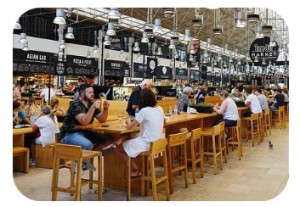 In malls across the country, food courts act as hubs where shoppers can eat, drink, and take breaks from comparing price tags. Along with sharing a common purpose, these corrals of restaurants and drink stands often serve similar fare, too. After all, walk into any food court and you’re likely to find mainstay chains like Sbarro, Subway and Panda Express alongside a couple of local options.
In malls across the country, food courts act as hubs where shoppers can eat, drink, and take breaks from comparing price tags. Along with sharing a common purpose, these corrals of restaurants and drink stands often serve similar fare, too. After all, walk into any food court and you’re likely to find mainstay chains like Sbarro, Subway and Panda Express alongside a couple of local options.
This dependable if slightly boring structure served retail centers well for decades as shoppers used food courts to refuel before getting back to buying. But that’s not what many of today’s consumers want. Rather than seeing food as a simple pit stop, these people want the meal they eat to be the main event of their trip. That’s partly because shopping just isn’t as exciting as it used to be. Thanks to e-commerce sites like Amazon, most consumers can acquire the goods they need without leaving the house. And when they do head out into the world, they’re looking for an interesting experience they couldn’t get elsewhere. Unfortunately for many food court vendors, that usually doesn’t include eating a greasy slice of pizza from Sbarro.
Instead, these adventurous eaters would prefer fresh sushi or perhaps a variety of gourmet crepes. Consumers can choose from either of these items at the DeKalb Market Hall, a collection of eateries that rests in the basement of a six-level shopping complex in Brooklyn called City Point. This 36,000-square-foot “food hall” is home to 40 independent vendors offering everything from pork chops to paella. Food halls like DeKalb draw in hordes of hungry consumers who often stick around to do some shopping afterwards. “DeKalb Market Hall has already had a tremendous impact on tenant traffic in the upper levels,” said Christopher Conlon, COO of City Point’s developer. Analysts estimate that the U.S. could have more than 200 food halls in operation by 2019, which is double the amount that were open in 2016. Still, opening a food hall doesn’t come cheap: at a place like DeKalb installing the proper infrastructure can cost up to $200 per square foot.
Questions:
- Do you think more mall food courts will eventually adopt the business model used by food halls like DeKalb?
- How has e-commerce affected the ways that people shop?
